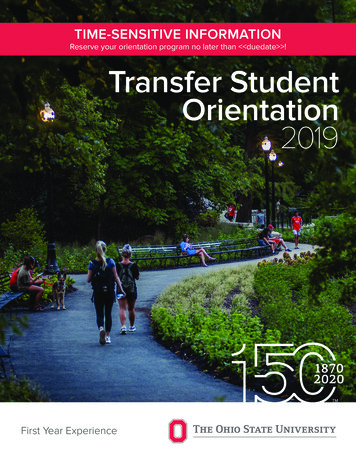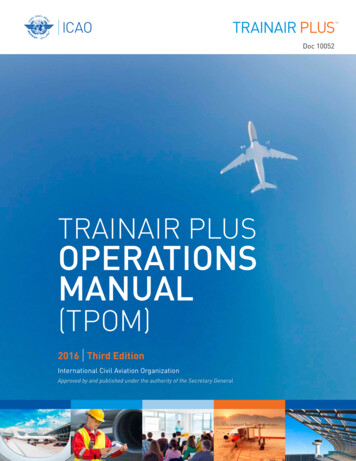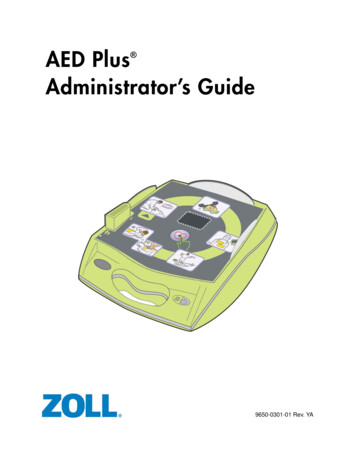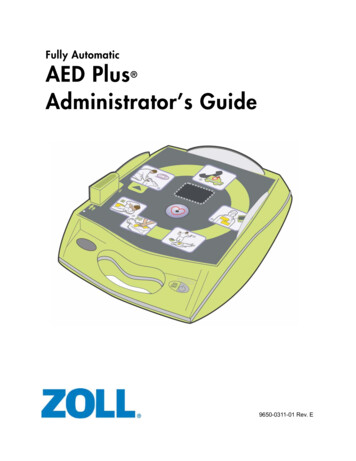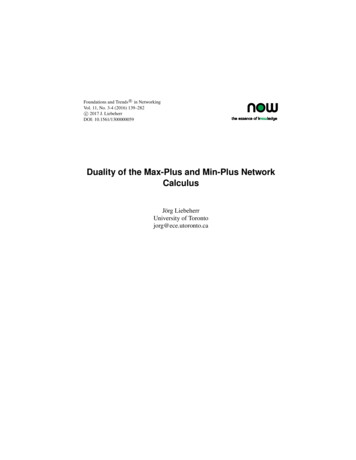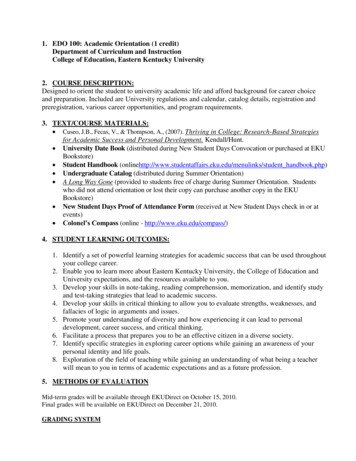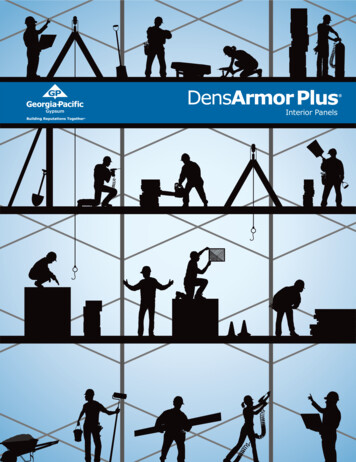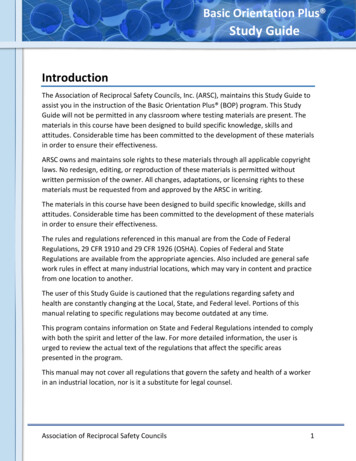
Transcription
Basic Orientation Plus Study GuideIntroductionThe Association of Reciprocal Safety Councils, Inc. (ARSC), maintains this Study Guide toassist you in the instruction of the Basic Orientation Plus (BOP) program. This StudyGuide will not be permitted in any classroom where testing materials are present. Thematerials in this course have been designed to build specific knowledge, skills andattitudes. Considerable time has been committed to the development of these materialsin order to ensure their effectiveness.ARSC owns and maintains sole rights to these materials through all applicable copyrightlaws. No redesign, editing, or reproduction of these materials is permitted withoutwritten permission of the owner. All changes, adaptations, or licensing rights to thesematerials must be requested from and approved by the ARSC in writing.The materials in this course have been designed to build specific knowledge, skills andattitudes. Considerable time has been committed to the development of these materialsin order to ensure their effectiveness.The rules and regulations referenced in this manual are from the Code of FederalRegulations, 29 CFR 1910 and 29 CFR 1926 (OSHA). Copies of Federal and StateRegulations are available from the appropriate agencies. Also included are general safework rules in effect at many industrial locations, which may vary in content and practicefrom one location to another.The user of this Study Guide is cautioned that the regulations regarding safety andhealth are constantly changing at the Local, State, and Federal level. Portions of thismanual relating to specific regulations may become outdated at any time.This program contains information on State and Federal Regulations intended to complywith both the spirit and letter of the law. For more detailed information, the user isurged to review the actual text of the regulations that affect the specific areaspresented in the program.This manual may not cover all regulations that govern the safety and health of a workerin an industrial location, nor is it a substitute for legal counsel.Association of Reciprocal Safety Councils1
Basic Orientation Plus Study GuideDisclaimerThe information contained in this Study Guide is presented as a GUIDE ONLY for thepromotion of illness/injury prevention and to assist companies in complying with rulesand regulations relating to General Safety. It is not a comprehensive review of allactions, which may be taken to minimize damage, loss or to successfully comply withFederal regulations.The producer makes no representation or warranties, expressed, implied or statutoryregarding the suitability of this material for use in developing a comprehensiveillness/injury prevention and safety program. Consult with your legal advisor concerningmatters involving legal issues.The Association of Reciprocal Safety Councils, Inc. (ARSC) and its members assumes noresponsibilities and expressly disclaims liability for any injury, including death or anyloss, damage or exposure arising out of, or in any way related to the use of this StudyGuide or training program or any written materials accompanying this program. Thecompany/ person using this Study Guide or training program accepts understanding ofthis disclaimer by using the Study Guide/training program.Additional Copyright InformationNo part of this Study Guide may be reproduced or transmitted in any form or by anymeans, electronic or mechanical, including photocopying, recording, or by anyinformation storage and retrieval system, without permission in writing from thecopyright holder.The Association of Reciprocal Safety Councils, Inc. (ARSC), does give permission to thecurrent member in good standing organizations, to make copies of the Study Guide asnecessary for their own in-house use.Selling, loaning, renting or giving any part of the Basic Orientation Plus program otherthan the Study Guide to others is a violation of copyright law and is infringement. It isalso a violation of the ARSC Common Guidelines. Any and all methods of enforcementwill be pursued.Association of Reciprocal Safety Councils2
Basic Orientation Plus Study GuideEveryone must help keep each other safe. Employers have the job of identifying anddescribing the hazards at your worksite You have the responsibility to learn and followthe ‘safe work practices’ that you will be taught.About the BOP Study GuideGoalThis BASIC ORIENTATION PLUS Study Guide was developed to provide help to traineestaking the BOP course. This study guide provides written introduction of many of thesafety principles that will be presented in that course. This study guide also introducesnumerous safety terms used in the BOP course. Becoming familiar with these safetyterms will promote better understanding of the course material and the course exam.IntroductionThis study guide introduces the key points that the BASIC ORIENTATION PLUS trainingprogram covers. This guide cannot cover all of the many safety details that the BOPcourse provides. To ensure your safety on-the-job as well as properly prepare you forthe course exam, you will need to focus on the safety principles and practices that arecommunicated in the BOP classroom course.Association of Reciprocal Safety Councils3
Basic Orientation Plus Study GuideHow to Use This GuideRead the information contained in this study guide. If there are terms you are not ableto pronounce, ask an instructor for assistance. It is likely that you will see these wordsagain in the course material and the exam. If you find it difficult reading and understanding the information in this studyguide, you will probably have difficulty reading and understanding your writtenexam as well. If you have never learned to read, we urge you to attend an adult learningprogram. (Your local safety council may be able to provide you with a local arealearning program to assist you with language and/or reading skills upon request.) You will be required to read in order to pass your written exam. If you are assisted in any fashion during the exam your badge reflecting yoursafety training will be valid on a local level only. It will not be consideredreciprocal training unless you are able to pass the exam unassisted in the Englishlanguage.Association of Reciprocal Safety Councils4
Basic Orientation Plus Study GuideIcon MapThe following icons may be used in this Study Guide to designate a specific action:Definition: Key term that is often field-specific and may beunfamiliarExample: Descriptive illustration to show or explain acourse conceptParticipant Note: Additional information to elaborate on apoint made in the course contentAssociation of Reciprocal Safety Councils5
Basic Orientation Plus Study GuideModule 1: IntroductionRecent available information from the Bureau of Labor Statistics (BLS) has reportedthere were millions of workers in the United States. Many of these workers had workrelated injuries and experienced work-related illnesses.To encourage employers to do more to protect their employees, OSHA issued voluntarysafety and health program management guidelines way back in 1989. These guidelineswere updated in 2016, and include seven key elements of effective safety and healthmanagement. These elements are essential to recognizing hazards and reducing and/oreliminating the workplace hazards we just discussed. The seven elements include: Management leadership Worker participation Hazard identification and assessment Hazard prevention and control Education and training Program evaluation and improvement Coordination and communication on multiemployer worksitesOwners have specific responsibilities related to workplace safety. OSHA requires theowner/plant to inform you of any known safety and health hazards on the actual jobAssociation of Reciprocal Safety Councils6
Basic Orientation Plus Study Guidesite, which include such things as hazardous materials, special processes, systemdesigns, and the like.As an employee, you are also responsible for following all safety regulations; informingyour employer of any unsafe condition; reporting all injuries (no matter how minor theyseem); and wearing the proper personal protective equipment. Remember, everyone ona job site has a responsibility to prevent injuries and incidents.As an employee, OSHA gives you the right to report identified workplace hazards thathave not been addressed. To report any and all workplace hazards to OSHA, you maycall toll free 1-800-321-OSHA or log in to the OSHA website at www.osha.gov.Module 2: Process Safety Management (PSM)The primary goal of the Process Safety Management of highly hazardous chemicals is toprevent unwanted releases of hazardous chemicals. Extra attention must be given tochemicals in locations that would cause the greatest danger to employees or theenvironment. This is done by evaluating the major process hazards (MPH).IntroductionProcess Safety Management requires thinking ahead to determine what could go wrongand then doing something to control those problems that could happen as a result offailures in process, procedures or equipment. In this way, potential hazards areidentified and prevented before the work begins. Process Safety Management paysspecial attention to highly hazardous chemicals that could cause serious injury to peopleor our environment.All plant sites must develop an effective process safety management program. Theinformation below describes the things that make up a PSM program.Association of Reciprocal Safety Councils7
Basic Orientation Plus Study Guide14 Basic Elements of Process Safety Management Employee Involvement in Process Safety Management – Employees must betrained and informed so they know how to prevent exposure to, or protectthemselves from, the hazards of chemicals. Process Safety Information – The employer must compile complete and accuratewritten information concerning process chemicals, process technology, andprocess equipment. This is essential to an effective process safety managementprogram and to process hazard analysis (PHA). Process Hazard Analysis (PHA) – This is an evaluation of the potential hazards ofa process or job and is one of the most important elements of a successfulprocess safety management program. A designated team works together toperform a PHA. Operating Procedures and Practices – Operating procedures tell you how tosafely perform a job. It tells the data to be recorded, operating conditions to bemaintained, samples to be collected and evaluated, and the safety and healthprecautions that must be taken all the time. Employee Training – All employees, including maintenance and contractoremployees who could be impacted by the hazards of chemicals must be trainedso that they know the hazards and how to protect themselves, their fellowemployees and the citizens of nearby communities.Association of Reciprocal Safety Councils8
Basic Orientation Plus Study Guide Contractors – Employees must be hired who can accomplish their job taskswithout compromising the safety and health of that employee or others. Pre-Startup Safety – All important elements such as start-up, shut-down andoperating procedures, including emergency procedures must be in place and theoperating staff trained before a startup. The development of P&IDs (Piping &Instrument Diagrams) must be available prior to startup for training assistance. Mechanical Integrity – An employer must operate and maintain the process in asafe manner and process equipment as designed in order to ensure safety.Equipment needs to be replaced when it is worn out. Work Permits – It is also important that non-routine work be wellcommunicated, not only to those who will do the work, but to any persons thatcould be affected by the work. Work Permits give authorization to workers to dospecial tasks only after many things are in place that can ensure the safety of thatwork.Association of Reciprocal Safety Councils9
Basic Orientation Plus Study Guide Non-routine work cannot be done without a signed, written permit that has allthe special precautions addressed within it.Examples: Examples of some of the different types of workpermits or procedures you may need for your job are:1. Line Breaking Procedures – These procedures willidentify what steps must have occurred before theline is opened that will assure that the line does nothave pressure on it and that the contents in the linecannot start to come out while the work is beingdone.2. Lockout/Tagout Procedures – This refers to thebasic steps of a typical Lockout/Tagout procedure asdiscussed earlier in this study guide.3. Cold Work Permits – This type of permit is used forwork which typically does not create any serioussafety concerns associated with the job: it will notproduce heat or a spark and the work is to be donein normal work areas.4. Confined Space Entry Permits – This permit hasspecial requirements that must be in place beforeanyone can enter a confined space. This includes airquality testing and emergency rescue needs.5. Hot Work Permits – This permit is used when thework that will be done or the tools and equipmentused to do the work could produce enough heat ora spark to ignite the materials around it. This permitrequires the results of the gas test that proves thatthis work can be safely done as well as what fireextinguishing equipment must be on hand duringthe work. Some other requirements are time anddate the work can be done, description of theobject to be worked on, and what emergencyequipment should be on hand.Association of Reciprocal Safety Councils10
Basic Orientation Plus Study Guide Managing Change – The management of change covers such areas as changes inprocess technology, changes in instrumentation, or changes in the equipmentitself. Not properly managing change has been a primary cause of manyaccidents. Special attention must always be made to be sure that pump types andsizes, and other equipment that is being replaced are identical to what is beingremoved. Investigation of Incidents – The investigation of an incident is the only way todetermine the underlying causes of incidents and then determine any steps thatcould prevent the same or similar events from reoccurring in the future. Thefocus of all investigations should be to obtain facts – and not to place blame. Forthis purpose, ALL accidents, injuries, and incidents (even “near-miss” incidents)must be reported to the proper personnel. Emergency Preparedness – Each employer must have an Emergency Action Planthat lays out what action employees are to take should there be a release ofhazardous chemicals. This plan tells how personnel will evacuate if there is arelease of hazardous chemicals. Employees must be trained so they will knowwhat to do if such a situation occurs. Compliance Audits – The employer must have trained personnel to audit thesite’s process safety management program. This audit is to ensure that the site isdoing what they say they will do, and also to help determine if what they aredoing meets the requirements of what it was designed to do. Trade Secrets – The employer must make all information necessary to complywith the standard available to those persons responsible for compiling theprocess safety information. However, confidentiality agreements may be used tosafeguard certain aspects of the process.Association of Reciprocal Safety Councils11
Basic Orientation Plus Study GuideModule 3: General SafetyIntroductionYou must know and follow all the site rules of the facilities you will be working in. Eachplant or facility will have its own rules for security and safety and you will receivetraining to learn what those rules are before you will be allowed to work at that site.Although this course cannot tell you the specific rules for the site where you will beworking, it can tell you some of the basic rules that apply to every site.This section will include information on: Safety BasicsOperating Motorized EquipmentWork PermitsErgonomic Work PracticesBloodborne Pathogens (BBP)Safety BasicsOnly employees with proper identification (and clothing) will be allowed into a facility.NEVER allow anyone to use your ID badge.Association of Reciprocal Safety Councils12
Basic Orientation Plus Study GuideYou must learn the plant site policies where you will work. You will be given thatinformation before you enter the plant to start your work. When you enter the plant’sproperty, you are required to follow its policies and rules.This will include the parking area where you park your vehicle while you are working.There may be restricted areas within a site where carrying cellular phones and pagersare prohibited. Remember that cameras are allowed only with special permission by thesite “owner.”Remember, everyone at the worksite has the responsibility and authority to stop anyunsafe act or condition in the workplace. The Stop Work Authority gives you the rightand obligation to stop a work activity if you have reason to believe your own safety or aco-worker’s safety is in jeopardy or if the work plan is not clearly established orunderstood. This is also true if you believe the situation could have a negative impact onthe environment.Stop Work Authority involves stopping the work, notifying supervision, and correctingany unsafe condition or act that could result in an incident before resuming the work.Operating Motorized EquipmentYou must have permission to operate any motorized equipment (even your ownvehicle). Remember, pedestrians (people on foot), bicycles, and emergency equipmenthave the right of way. Also remember: vehicles must stop not only for pedestrians, butthey must also stop for trains or when they are directed by a flag person.Association of Reciprocal Safety Councils13
Basic Orientation Plus Study GuideCranesCranes can never be operated in a position where their boom or line can come within 10feet of any overhead power line without special approval. Crane operators must neverallow their load to swing over people. The load being handled by a crane must becontrolled by the use of a tag-line. Crane operators can only take directions from adesignated spotter. The spotter can verbally communicate or use hand signals to directthe crane operations.ForkliftsApproximately 100 workers are killed each year in a forklift accident. Many of thesedeaths are caused when the forklift overturns. Another major cause of death is whenpedestrians are struck and killed by forklifts.Association of Reciprocal Safety Councils14
Basic Orientation Plus Study GuideWork PermitsPlant facilities utilize permit programs to assure that all the preliminary requirementsare met and permits are issued before a job can begin.Examples of some of the types of permits that are used at worksites are: Hot WorkConfined Space EntrySafe WorkLine Entry/BreakingLockout/Tagout permitsErgonomic Work PracticesThe science of finding the best fit between you and your job conditions is known asergonomics. Some examples of good ergonomic practices include: Good postureProper body mechanicsGood placement of computer equipmentComfortable handles and gripsResearch has shown that early reporting of pain or discomfort helps minimize theinjuries associated with work tasks. If you experience pain or discomfort as a result ofyour work activities, you should report this information to your supervisor as soon aspossible.Association of Reciprocal Safety Councils15
Basic Orientation Plus Study GuideBloodborne Pathogens (BBP)Definition: Bloodborne pathogens (BBP) are diseasecausing microorganisms that are present in human bloodand certain bodily fluids. These microorganisms can infectand can cause disease when they enter your body.Universal Precautions means that you treat all blood and body fluids as if they areinfectious for BBP. Only trained, qualified, and authorized workers should attempt toclean up blood or body fluids on any surface. Examples of Universal Precautions include,but are not limited to: Practicing personal hygiene (hand-washing) Wearing gloves or eye protection to prevent exposure Using engineering and work practice controls to limit exposureAssociation of Reciprocal Safety Councils16
Basic Orientation Plus Study GuideModule 4: Hazard CommunicationsEveryone must help keep each other safe. Employers have the job of identifying anddescribing the hazards at your worksite. You have the responsibility to learn and followthe ‘safe work practices’ that you will be taught.IntroductionAll employees have the right to know the safety and health hazards of chemicals theymay be exposed to on the job. This is important to reduce illness and injury.The information within this section will summarize: Some general requirements of OSHA’s Standard 29 CFR 1910.1200What makes a chemical “hazardous”General requirements of a Hazard Communication ProgramHow information of hazardous chemicals is communicated to employeesExamples of some hazardous chemicalsThis information will help you understand that there may be safety and healthhazards at work. It is your responsibility to protect yourself from these hazards.Safety Standard 29 CFR 1910.1200 - OSHA is a part of the United States FederalGovernment that was created to help reduce the injury and health problems that canoccur in industry. OSHA’s Safety Standard 29 CFR 1910.1200 is sometimes called the“Right-to-Know” law. This standard was given this nickname because this law says thatAssociation of Reciprocal Safety Councils17
Basic Orientation Plus Study Guideemployees have the “right to know” the hazards in their workplace and have the “rightto know” how to protect themselves.WHAT MAKES A CHEMICAL “HAZARDOUS”?A Hazardous Substance is any substance which can cause injury (a physical hazard) orcause illness (a health hazard) in a person.A hazardous substance can hurt you in one of two ways: If the substance can cause an explosion, fire, or cause a violent reaction, it iscalled a physical hazard. Gasoline is an example of a substance that can create aphysical hazard. If a substance causes you to get sick or become ill, then it creates a health hazard.Participant Note: In chemicals that produce a healthhazard, the substance will cause either chronic healthconditions (conditions or symptoms that do not go away)in the body, acute health conditions (conditions orsymptoms that cause sudden and often intense reactions,that will go away after a time), or both.Association of Reciprocal Safety Councils18
Basic Orientation Plus Study GuideGeneral Requirements of a Hazard Communication ProgramThe employer must inspect the worksite to find out if there are hazardous substances. Ifthere are, OSHA requires them to have a written Hazard Communication Program.This program will explain how your employer will make sure you understand about thehazards at the worksite. Some of the things that are included in this program are: Lists of Chemicals Labels and Warning Signs Safety Data Sheets (SDS)Chemical ListsEmployers must have a complete list of all hazardous substances at their worksites.Labels and Warning SignsAll containers (from small bottles to big vessels) must be labeled, tagged, or marked toidentify what is in them. The purpose of warning signs in the workplace is to tell youinformation about the hazards. Be sure that you read and understand the warnings thesigns communicate.Association of Reciprocal Safety Councils19
Basic Orientation Plus Study GuideThere are two different types of labeling systems that are used on the big vessels anddrums where you work. The National Fire Protection Association (NFPA) labeling system The Hazardous Materials Identification System (HMIS).Although these are different systems, they have much in common. The purpose forwarning signs, the NFPA, and the HMIS labels is to give you hazard information.Look at the pictures of these labels.The HMIS and the NFPA labels are alike in many ways: They use the same color codes:blue health, red flammability, yellow reactivity.Another thing they have in common is the “number” warnings that both systems use.The numbering system ranges from 0 to 4.Association of Reciprocal Safety Councils20
Basic Orientation Plus Study GuideExample: On the blue health area, 0 no health hazard, 1 slight health hazard, 2 moderate health hazard, 3 Extreme Danger 4 very severe or deadly health hazardIf a substance is not marked and you are not sure what a substance is, ask yoursupervisor. Sometimes you will need more information than can be put on a label or awarning sign. If you need more information, the best place to look is to the chemical’sSDS (Safety Data Sheet).Information Found in a SDSA Safety Data Sheet (SDS) is written or printed material about a hazardous chemical.Chemical manufacturers and importers of hazardous chemicals are required to developSDS for hazardous chemicals. Employers, in turn, must have a current SDS for eachchemical on the list of chemicals used by their company.What kind of information can be found in an SDS?Each SDS must contain: The identity used on the label The physical and chemical characteristics of the hazardous chemical (such as thevapor pressure and flash point) The physical hazards of the hazardous chemical (such as any fire, explosion, andreactivity hazards) The health hazards of the chemical, including the signs and symptoms ofexposure and any medical conditions resulting from exposure to the chemical The primary routes of entry The relevant exposure limits Whether the chemical is a cancer-causing agentAssociation of Reciprocal Safety Councils21
Basic Orientation Plus Study GuideParticipant Note: PEL (Permissible Exposure Limit) is themeasurement OSHA uses to identify the maximum amountof substance that a person can safely be exposed to at anyone moment in time. Another measure for exposure limitsdetermines how much of an exposure is allowable within anormal 8-hour workday. This measurement of exposure iscalled a “TWA” meaning Time-Weighted-Average (of 8hours).How Information of Hazards Is CommunicatedAnother part of the written Hazard Communication Program will tell how your employerplans to warn you about the hazards that may exist. Your employer will warn you aboutthe hazards and how to protect yourself. In fact, one of the main goals of the BOPcourse is to provide training which covers the general information you need.After this training, the worksite you go to will train you on the site-specific hazardinformation that you need to know.Additionally, the labels and warning signs will serve as another form of hazardcommunication. Using the site’s SDS book will also be a way the employer expects youto learn about the hazards of a specific chemical. All of these methods ofcommunication work together to make sure you have the information you need to besafe.Association of Reciprocal Safety Councils22
Basic Orientation Plus Study GuideExamples of Some Hazardous ChemicalsEach work area has different types of hazardous chemicals. It is important to realize thatchemical hazards do not only exist inside containers, but sometimes chemical hazardsexist outside the container as well.Examples of such chemical hazards would be: Asbestos Lead RadiationAsbestos: Asbestos contains fibers that are very strong and resistant to heat andchemicals. Asbestos is often used to insulate vessels and piping. Asbestos is used insiding, shingles and floor tiles. Under normal conditions, these fibers do not pose ahealth hazard but they do become hazardous if something happens to cause thesefibers to be released into the air. When released in the air these fibers can cause lungcancer, gastrointestinal cancer, or a lung condition called asbestosis. You must beproperly trained and wear the proper PPE if you work where there are dangerousconcentrations of asbestos.Association of Reciprocal Safety Councils23
Basic Orientation Plus Study GuideLead: Lead is commonly added to industrial paints because of its corrosive resistance.Just like asbestos, lead does not pose a health hazard under normal conditions. If apainted surface is burned during welding or the paint becomes airborne throughsandblasting, grinding or sanding, then the lead can become a health hazard. If lead isingested (oral) or inhaled (breathing) the exposure can cause health problems in yourblood, urinary system and reproductive system. You must be properly trained and wearthe proper PPE when lead exposure may occur.Radiation: The X-raying of equipment, microwaves, and lasers are all forms of radiation.When equipment is being used that emit radiation, it is important that you obey allwarning signs and never go through radiation barricades.If you are doing work that may require you to work near such chemicals where exposurecould present physical harm, then you will receive special training on how to takeproper precautions against exposure.Association of Reciprocal Safety Councils24
Basic Orientation Plus Study GuideModule 5: Personal Protective Equipment“PPE” means Personal Protective Equipment. Before you do any work, you must knowwhat could hurt you. Then you can choose the right PPE for the job. You mustunderstand how the PPE will protect you, and you must know how to inspect it, wear it,and store it.IntroductionPersonal Protective Equipment (PPE) is specially designed to protect you from head-totoe. Each type of PPE is made to protect you from certain hazards or dangers so youmust know what danger or hazard is present before you can choose the proper PPE.The information within this section will describe: Types of the PPE that you may need to use When PPE must be used What you must know about the PPE you useAssociation of Reciprocal Safety Councils25
Basic Orientation Plus Study GuideMany Types of PPE are used for Protection from HazardsYou must wear some PPE to enter a plant no matter what job you will be doing there.More than likely, you may need to wear sa
About the BOP Study Guide Goal This BASIC ORIENTATION PLUS Study Guide was developed to provide help to trainees taking the BOP course. This study guide provides written introduction of many of the safety principles that will be presented in that course. This study guide also
